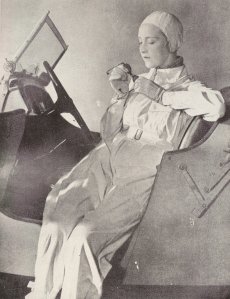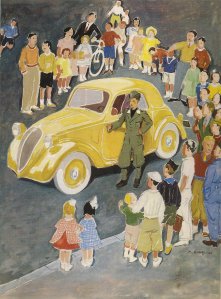Simanaitis Says
On cars, old, new and future; science & technology; vintage airplanes, computer flight simulation of them; Sherlockiana; our English language; travel; and other stuff
LE BELLEZZE DELLA FIAT
THE BEAUTIES of Fiat, le bellezze della Fiat, have been part of this Italian automaker’s image since the very beginning. They did more than reflect the era; at times, they were the source of change. Here’s a sampling from Posters from the Fiat Archives 1900-1940, commentary by Cesare De Seta and Emanuele Pirella, Gruppo Editoriale Fabbri, 1991.
F.I.A.T., Fabbrica Italiana di Automobili Torino, was established by Giovanni Agnelli with several investors in 1899. Its 3 1/2 HP, of which 24 were built, paid homage to the contemporary Benz. In this 1899 poster by Giovanni Carpanetto, the tiller is manned by an evidently capable motorist; no wonder the woman appears serene.
In 1906, F.I.A.T. changed its name to Fiat. And, by 1919, the capable motorist—now at the universally adopted steering wheel—is a woman. This advertisement is by Golia (Eugenio Colmo), caricaturist, illustrator, artist and potter.
A mere six years later, Fiat’s advertising message was voluptuously into the Flapper Era. Plinio Codognato was a poster artist specializing in transport; he became known as the “poster poet of speed.”
This gal is racy even today. She’s clearly in the same sisterhood as the “Somewhere west of Laramie” girl, another flapper changing the image of the automobile—and of women.

Not from the Fiat archives, but a milestone in advertising the automobile. The ad for the Jordan Playboy, art by Fred Cole, from the Saturday Evening Post, June 1923.
In Europe as well as America, the automobile meant more than just mobility. It could offer elegance.
Artist Giuseppe (Nino) Romano, artist and illustrator, also did straightforward product images for Fiat. In this contrasting bit of art, you know that everyone shown is elegant—and wealthy. I love the casually tossed fur.
This sportswoman in an uncredited image isn’t exactly fashionably dressed. But you know from her helmet, coveralls, driving gloves and sunglasses that she’d be the kind of woman whose company you’d savor.
Fiat introduced the 500 Topolino (“Little Mouse”) in 1937 as its Everyman’s car, and this image reinforces that in every way. Artist Franco Mosca was recognized internationally for his Photorealism genre, though this image appears closer to Socialist Realism. The young woman is confident of a bright future, brought about by her fervent political beliefs. Also, typical of lots of automotive advertising, the car is out-of-scale large—or she’s a particularly well-formed tiny fantasy.
From 1922 to 1945, Italy succumbed to Fascismo. This 1936 sketch is in a gentle folksy genre. But notice the stylish fatigues of the driver standing next to her Topolino. Artist Massimo Quaglino was a landscape painter and caricaturist as well as Fiat illustrator.
The Fiat 2800, produced between 1938 and 1944, was an automobile for the Italian elite. By 1938, Benito Mussolini was already annexing European and North African territories, often on the flimsy argument that the conquered spoke some variant of Italian. War was inevitable.
This last image conveys a sense of dark resignation. There’s elegance here, but it’s coming to an end. ds
© Dennis Simanaitis, SimanaitisSays.com, 2013









In the 1936 Quaglino sketch, the woman in fatigues seems to be added later. There is a definite cutline around her. The original version was probably not ‘nationalistic’ enough.
Hi, Bill,
I see what you mean. I reread the two commentaries, but there’s no mention of this. Note, it’s identified as a sketch for a brochure. Your theory is an interesting one.
Dennis, thanks again for collecting more classic images for us in one place. Best of show . . . Laramie.
Adding to Romano’s wealth and excess is the casually carried fur far left . . . not to mention the mink stole on the lap of the seated woman. Might fur covered seats have been a 514 option? And the prominent street lamps bring to mind those favored by Fritz Schlump (Feb 4), but Romano’s interpretation is more elegant.